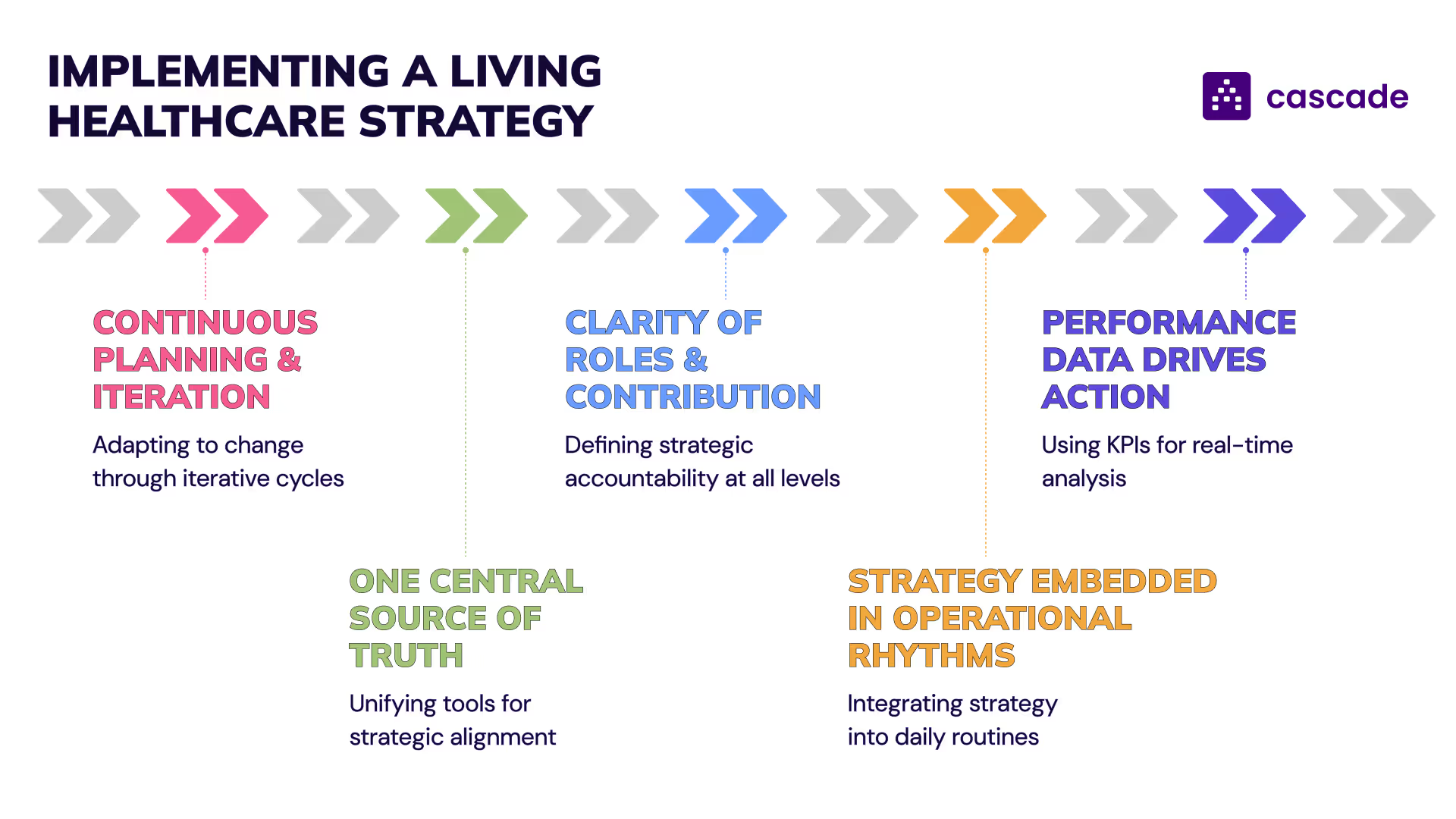In healthcare, the problem isn’t a lack of strategic planning. It’s that the strategy rarely makes it past the page.
Long-term visions are defined. Goals are documented. But execution often stalls when those strategies aren’t connected to the daily decisions, work, and systems across the organization.
The result? A growing gap between what management sets out to achieve and what actually gets done.
Healthcare organizations today are navigating increasing complexity: tighter margins, evolving public health expectations, and greater scrutiny from regulators, patients, and stakeholders. In this context, strategic plans can’t just look good on paper. They need to function as living systems supporting the flow of decisions, data, and outcomes across every level of the organization.
“The key to the healthcare industry’s economic recovery is to pursue the $1 trillion improvement opportunity in care delivery transformation, administrative simplification, clinical productivity, and technology enablement. Experience shows that to fully realize this opportunity, leaders must invest and act purposefully even as they focus on necessary near-term performance enhancements.”
—McKinsey
That tension between near-term demands and long-term goals is where many providers struggle. The future of healthcare strategy depends on turning planning into performance and vision into operational clarity.
The Visible And Invisible Costs Of Strategic Disconnect
Disconnected strategies create a chain reaction of inefficiencies that affect both outcomes and organizational health. Some are easy to spot. Others run deeper and are often more damaging.
Visible costs: Where it shows
These are the challenges that show up in board meetings and operational dashboards:
- Delayed or failed initiatives
- Missed regulatory or compliance milestones
- Duplicated efforts across departments
- Inefficient use of resources and unnecessary rework
Many health systems respond by tweaking projects or reallocating teams but without addressing the systemic misalignment at the core.
Invisible costs: Where it hurts
Some costs aren’t visible in reports but are felt every day across hospitals and healthcare organizations:
- Burnout, as clinical and administrative teams lose sight of purpose
- Decision fatigue from unclear or conflicting directives
- Erosion of momentum when progress isn’t visible or tracked
- Diminished trust in leadership and organizational direction
“Disconnected strategy erodes performance and confidence. The cost isn’t always on a spreadsheet but it shows up in misaligned work, duplication, and organizational fatigue. These hidden costs directly undermine operational performance, strategic growth, and the organization’s ability to adapt to external pressures.”—Devina Patel, Director of Strategy Execution, Cascade
.avif)
Why Traditional Strategic Planning Models Fail In Healthcare Today
Most healthcare systems don’t suffer from a lack of strategy, they suffer from outdated strategy planning and execution processes that weren’t built for the current complexity of the industry.
Static, long-term Planning cycles
Annual or quarterly planning cycles are too slow for an environment where care models, financial policies, and patient needs change month to month.
Fragmented tools and processes
Strategies are still being built and tracked in siloed tools such as PDFs, PowerPoints, and spreadsheets that can’t adapt in real time. These formats were never designed to support continuous execution across a complex organization.
📚 Recommended read: Why Strategy Fails: When Strategy Stays On The Slide
Strategy as an isolated function
In many healthcare systems, strategy still lives at the leadership level, disconnected from frontline operations. But real success depends on empowering everyone—clinical staff, operations, administration—with clarity on how their work contributes to the broader plan.
“Healthcare providers must boost performance and seek growth opportunities. Organizations not targeting productivity improvements in core operating functions each year are likely falling behind.”
—McKinsey

As the market and patient expectations evolve, the status quo simply won’t cut it. What’s needed is a better model.
What Leading Healthcare Organizations Are Doing Differently
Top-performing providers are adopting a fundamentally different approach to healthcare strategy execution. They’re moving from episodic planning to continuous action, from fragmented models to integrated systems.
Strategy as a shared operating system
Leading healthcare organizations are rethinking strategy as infrastructure. It’s no longer a document, it’s a dynamic process embedded across services, functions, and clinical operations.
📚 Recommended read: The Missing Layer in the Enterprise Tech Stack For Strategy-Led Performance
By using centralized platforms like Cascade, they enable real-time visibility into strategic priorities, align work across departments, and empower decision-makers at every level to respond faster and smarter.
Perley Health: From Fragmentation to Focus
Perley Health, a Canadian non-profit specializing in long-term and veteran care, faced a familiar challenge: big ambitions, fragmented plans, and siloed execution. Strategy lived in documents—PDFs, Word files, one-off reports—scattered across departments. Teams were working hard, but not always in sync.
Then came a shift.
With a renewed focus on transformation, they centralized their strategic planning and execution in Cascade. Every initiative was mapped to the organization’s long-term vision enabling leadership to gain visibility into progress and ROI.
“Cascade helped us go from a document to something that people are living and breathing every day. Strategies are intended to be operationalized - that’s why they exist."—Rebecca Wilson, Director of Strategy & Transformation, Perley Health
This shift didn’t just improve transparency, it sparked momentum. Today, Perley Health is making measurable progress toward its bold goal of doubling the number of seniors it serves. Strategy is no longer an annual conversation. It’s a daily practice.
%2520(1).avif)
ALS Association: Aligning Strategy to Mission
As the largest philanthropic funder of ALS research in the world, The ALS Association is no stranger to bold goals. But boldness alone wasn’t enough. Disconnected strategic plans across departments led to inefficiencies, blurred accountability, and missed opportunities to scale impact.
To move faster and with greater precision, The ALS Association partnered with Cascade.
With a centralized system for tracking long-term goals and initiatives, they brought clarity and focus to five key priorities. Cascade became the single source of truth—driving alignment, improving governance, and enabling faster reporting at every level.
“Cascade checked all the boxes for our strategy execution. It provided us with the structure we needed to organize our work and report with clarity.”—Michelle Sweeney, VP of Operations Strategy, The ALS Association
The results? Stronger agility, sharper decisions, and better execution across the board. Instead of chasing updates, leaders now lead with insight. Instead of reacting to change, they’re driving it.
%2520.avif)
Whether it’s accelerating the fight against ALS or ensuring strategic funds like the Ice Bucket Challenge deliver maximum impact, The ALS Association proves that strategy-led performance isn’t just possible, it’s essential.
A broader trend toward systemic execution
This shift is happening across the industry. Health systems, payers, and providers are building execution infrastructure to connect strategy to real-time work.
“The emergence of integrated datasets and new technologies presents opportunities for value creation across segments. More than 70% of healthcare organizations are pursuing generative AI solutions.”—McKinsey
The lesson? Organizations that treat strategy as a living system are more adaptive, aligned, and effective.
Strategy-Led Performance: A New Leadership Mandate
In this environment, the role of healthcare leaders is evolving. It’s no longer enough to define strategy, they must make it operational.
From plans to platforms
Healthcare leaders don’t need more complexity. They need systems that connect the dots between long-term vision, daily decisions, and measurable results.
“Too often, strategy becomes a conversation that’s separate from daily decision-making. That gap is where performance falters and opportunities are lost.”—Laura Blackmore, Head of Strategy Execution, Cascade
A Strategy-Led Performance model ensures that strategic intent turns into consistent execution everywhere from the C-suite to the patient floor.
The Path Forward: Turning Strategy Into A Living System
A successful healthcare strategy is one that adapts, informs, and empowers. Here’s what it looks like in practice:
1. Continuous planning & iteration
In a sector defined by constant change like policy shifts, evolving patient needs, and advancing technologies, static planning no longer works. High-performing organizations are adopting iterative planning cycles, enabling them to reassess priorities, resource allocation, and care models without waiting for the next fiscal year.
2. One central source of truth
Fragmented tools lead to fragmented execution. A unified system allows everyone—executives, department heads, and frontline staff—to access the same strategic direction, track performance, and adjust work in real time.
This centralization reduces duplication, eliminates blind spots, and supports better cross-functional coordination.
“Digital tools should build on established and successful solutions to enhance operations, improve patient and physician experiences, and ensure investments pay off.”—McKinsey
📚 Recommended read: How To Implement Effective Strategic Planning In Healthcare
3. Clarity of roles & contribution
Too often, strategy fails because people don’t know how they fit into it. Successful organizations define strategic accountability at every level, translating enterprise goals into clear, actionable responsibilities for departments, teams, and individuals.
4. Strategy embedded in operational rhythms
Strategy isn’t a quarterly exercise, it’s a daily habit. Forward-thinking providers are embedding strategic discussions into leadership reviews, staff meetings, and QBRs. Progress is tracked in real time, blockers are addressed early, and teams are continuously reminded of the “why” behind the work.
5. Performance data that drives action
Metrics without context don’t drive change. Organizations leading in strategic maturity identify healthcare KPIs that truly reflect progress, not vanity metrics. They build dashboards tied directly to strategic objectives, enabling real-time analysis and smarter decisions.

The Cost Of Inaction Is Higher Than You Think
The healthcare industry is shifting toward value-based models, digital transformation, and integrated care delivery. Organizations that cling to outdated strategic processes will fall behind.
Disconnected strategy isn’t just inefficient. It’s a barrier to growth, agility, and impact.
The good news? You don’t need to start over. You just need the right system to bring your strategy to life clearly, consistently, and at every level of the business.
“The organizations that succeed aren’t the ones with the most detailed plans. They’re the ones who know how to adapt and ensure every team knows how to act on that strategy daily.”—Devina Patel, Strategy Execution Director, Cascade
If you're rethinking how strategy gets done in your organization,
👉 Explore Strategy-Led Performance for Healthcare

.avif)

.avif)


.png)
.jpg)
.jpg)



